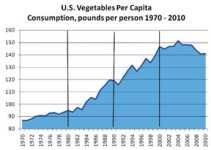
As I prepare for the summer, I can’t help but wonder what lies ahead for vegetable growers in light of the prolonged recession we have experienced. Questions arise as to its impact on the health and security of our citizens. About 33% of adult men and 35% of U.S. women were obese in 2005-2006, according to a comprehensive survey by the federal government. That’s more than 72 million people, according to the U.S. Centers for Disease Control and Prevention. Today, nearly one in three elementary age children are overweight or obese and four in 10 have high cholesterol levels. The number of children who are overweight has tripled since 1980. Without change, USDA says that one in three children in America born in 2000 or later will suffer from diabetes at some point in their lives, and many others will face chronic obesity-related health problems like heart disease, high blood pressure, cancer, and asthma.
Policymakers recognized that something must change and implemented several programs in the 2008 Farm Bill to address these issues, putting a priority on increased consumption of whole grains and fresh fruits and vegetables. A relevant question to ask is whether all of these programs are having an impact on U.S. consumers.
Peaks And Valleys
The produce industry has seen phenomenal growth over the years as consumers recognized the value of eating more fruit and vegetables and as food consumed away from home increased. Improved technologies made it easier to supply higher quality fruits and vegetables to consumers. I often characterize the decades of the 1980s and 1990s as the golden era of the produce industry. The 1970s per capita consumption of fresh vegetables in the U.S. averaged 90.5 pounds per person. Per capita consumption increased to 103.9 pounds in the ’80s and 128.2 pounds in the ’90s. The 2000s saw this rise again to 146.5 pounds per person. Using these averages, it would appear that vegetable consumption continues to grow and that we should be seeing improvements in the health of the U.S. population.
The more disturbing statistics in these data are the consumption trends since 2000. Per capita consumption of fresh vegetables in 2000 was 146.8 pounds per person. It peaked at 151.4 pounds in 2004 and has since fallen to 140.7 pounds in 2009 and a predicted 141.2 pounds in 2010. The per capita consumption chart above shows U.S. consumers increased their consumption through calendar year 2000 and have since leveled off or slightly declined their consumption of fresh vegetables.
Recession Regression
Avoid These Mistakes When Flying Drones Over Your Farm Field
One might argue the recession that began in 2008 had a significant impact, forcing consumers to choose less expensive alternatives, but declines in consumption actually began in 2005. It is no surprise some producers have struggled over the last decade as increased regulation elevated costs, forcing consumers to consider lower cost alternatives higher in sugars and fat.
An alarming study published in the Journal of Food Composition and Analysis in 2004 revealed Americans were getting nearly one-third of their calories from junk foods: soft drinks, sweets, desserts, alcoholic beverages, and salty snacks. The produce industry has been unable to match the marketing muscle of junk food providers. Is it any surprise that the general health of the U.S. population has declined?
As we move into negotiations for the next Farm Bill, it is important policymakers examine the objectives they hope to achieve in that legislation. There was progress in the 2008 Farm Bill with increased budget for fruit and vegetable consumption.
The budget crisis in Washington is going to call into question the priorities for these programs. Even if the global economy is able to right its course and we have renewed economic growth, it is unlikely diets will improve without education and promotion of healthy diets.
0
1
5
Recession is Hard to Digest
John VanSickle is a professor in the Food and Resource Economics Department at the University of Florida in Gainesville. See all author stories here.











